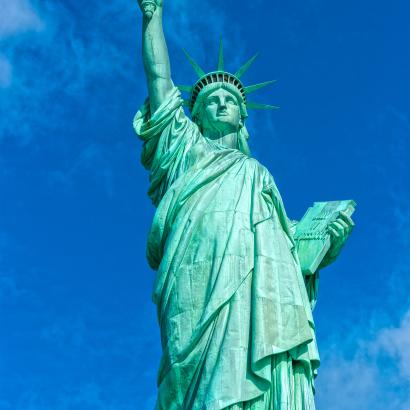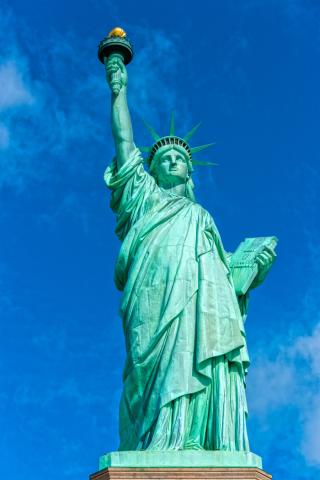Editor’s Note: This is adapted from a speech given at the Mont Pelerin Society Meeting at Fort Worth, Texas, on May 21, 2019. (The Mont Pelerin Society is a classical liberal organization that was started in 1947 in Switzerland. The first attendees included free-market economists Friedrich Hayek, Milton Friedman, and George Stigler. Hayek was later an honorary fellow with the Hoover Institution and Friedman and Stigler became Hoover Institution senior fellows.) At the same meeting, David R. Henderson, a research fellow at Hoover, delivered a talk in support of a non-interventionist foreign policy, which was adapted and published in Defining Ideas on May 28, 2019.
Introduction
Thomas Jefferson foresaw the United States evolving from a small federation along the Atlantic coast of the New World into an “Empire of Liberty.” He coined that phrase and imagined the new republic’s potential to spread freedom around the world even before the Revolutionary War was won. This is Libertarianism properly understood. Although some schools of Libertarian philosophy, including many scholars at the CATO Institute as well as the Libertarian political party, promulgate a non-interventionist view, it is a view that does not square with Jefferson and the founding principles of the nation. Once a nation commits to the idea of universal human liberty, rooted in the words “all men are created equal” and endowed with the unalienable rights of “Life, Liberty, and the Pursuit of Happiness,” the logical endpoint is a military with a different composition, a different organization, and a different purpose than any military in history.
Echoing the construction of President Abraham Lincoln’s Gettysburg Address, consider my suggestion that the three pillars of a Libertarian foreign policy are of Liberty – meaning the soldiers who serve are from all corners of the world, by Liberty – meaning that the Army comprises volunteers only, and for Liberty – meaning that its fully realized purpose is the defense of human liberty beyond the nation’s borders. This latter point recognizes the peculiar nature of the American nation’s Promethean, rather than imperial, power. Its development can be traced from the Monroe Doctrine in the 19th century to the Truman Doctrine in the 20th century to the presence of hundreds of thousands of U.S. troops deployed peacefully at this moment.
Of Liberty: The Immigrant Army
President Trump often asks why the United States is “the only country in the world” that has “ridiculous” immigration policies. During a speech in October 2018, he threatened to end birthright citizenship with an executive order even though it is enshrined in the Constitution, arguing that the U.S. is the only country that has such a policy. Trump is right that America is unique, but likely not in the way he thinks. There are two facts about American exceptionalism that we would do well to appreciate before making any policy changes.
Figure 1. U.S. Maintains Economic Leadership
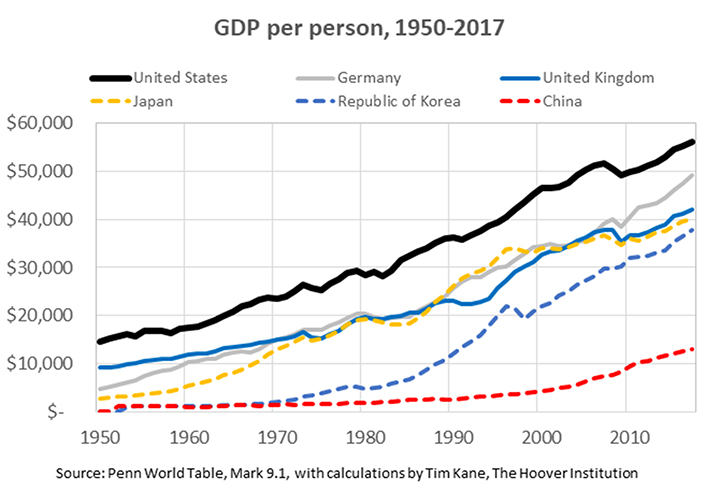
Fact 1: The United States is the richest nation in the world. It also happens to be the richest nation in history. And the word rich has many meanings here. More than money, America’s rich economy serves as the foundation of its superpower status and funds its dominant military strength. There are many, many factors that explain economic growth and many, many books about it (including one I co-authored with Glenn Hubbard called Balance: The Economics of Great Powers), but the gap is undeniable in comparative GDP per capita data. The average GDP per person in the United States is 15 to 25 percentage points higher than peer nations in Europe and Asia and much higher than China or Russia. To be sure, there are a handful richer, smaller states such as Qatar and Luxembourg (the largest is Switzerland), but no great power is within one-sixth of America’s economic strength.
Fact 2: The United States welcomes more immigrants than any other country, just counting the legal immigrants. In absolute numbers of permanent new citizens, no other country comes close. Though rare in the present, this openness to immigration mirrors the great powers of history, notably ancient Rome and Ottoman Turkey.
Despite contentious newspaper headlines and political spats, the reality is that every year, 1.1 million people born elsewhere are granted permanent legal residency and the right to take the oath as naturalized American citizens. More importantly, this welcoming policy is based on deep public support for immigration. Opinion polls reveal Americans support diversity and immigration more than do citizens of any country in Europe.
The riddle is: Are these two exceptional features related? Most likely, yes. Being a nation of immigrants is a fundamental cause of extraordinary prosperity and military power for the United States. Not only is immigration central to the American identity, but it is also what military strategists call a force multiplier.
Imagine an alternative history that diverged in 1820 with restrictionist immigration policies that prevented the Irish wave. Intuitively, we know that our present population of 325 million souls would be smaller, but how much smaller? Using data from the U.S. Census starting with the year 1820 (population 9.6 million), I calculated that cutting immigration levels in half in that year generates a modern U.S. population of 228 million. Basically, the U.S. would have one hundred million fewer Americans in 2019, and 32 million fewer people in 1940. Could an immigrant-halved America have won the Second World War? The Cold War? Probably not.
The positive impact of migrants extends far beyond multiplying the population. Immigrants have a greater tendency to volunteer for U.S. military service than do native-born Americans. In fact, 43 percent of the U.S. armed forces during the Civil War years (1861 to 1865) were immigrants or the sons of immigrants. At the time, only 13 percent of U.S. citizens were foreign-born. How well did they fight? If medals are a measure, immigrant soldiers in the U.S. have been consistently heroic. Twenty percent of recipients of the Medal of Honor have been first-generation immigrants, again nearly double the native-born proportion.
Immigrants enhance security with brainpower as well as brawn. Look no further than refugees such as Albert Einstein or modern tech entrepreneurs such as Sergey Brin (founder of Google) and Steve Jobs (son of a Syrian father) to understand the impact on the nation’s technological advantage. After World War Two, the Pentagon understood that winning the battle for brains was vital to national security. The recruitment of ex-Nazi scientists under Operation Paperclip brought more than a thousand German engineers and scientists to the U.S. to work on U.S. missile and space programs, notably Wernher von Braun.
By Liberty: The Volunteer Force
Throughout the nation’s history, the Army and Navy have struggled to evolve away from the military tradition of treating manpower as forced labor, a tension that culminates in the periodic use of conscription to fill the ranks during wartime. That was until the Gulf War of 1990 and the wars in Afghanistan and Iraq following the 9/11 attacks. Our era is extraordinary: the vindication of a volunteer army.
Conscription is deeply offensive to liberty, and its use during the Civil War led to infamous riots in New York City. Similarly, use of the draft during the Vietnam war is arguably why that war was lost on the home front. After President Nixon fulfilled his campaign promise to end the draft and institute an all-volunteer force (AVF) – over the objections of most Pentagon flag officers – the Vietnam protests dwindled. Yet the damage was done, and America retreated from South Vietnam in 1973 – the same year the AVF went into full effect.
The godfather of the AVF, Martin Anderson, was a Hoover Institution colleague who passed away in 2015 at the age of 78. Anderson was working to end the draft before most of us were born. In 1967, he urged presidential candidate Richard Nixon to embrace the cause, relentlessly nudging Nixon to make the issue central to the 1968 election. As another colleague, David Henderson, documented, “Anderson wrote the anti-draft speech that Nixon gave on CBS radio during the 1968 election.” After the election, Anderson was the key White House adviser who overrode Pentagon resistance, organized the famous Gates commission, and coordinated the legislation ending conscription once and for all in January, 1973.
One could be forgiven for thinking this battle over the draft was won, but no. A staunch few critics still doubt the wisdom of voluntary military service, and persist in saying only coercion can bring in quality people to the lower ranks. A young James Fallows called attention to the skyrocketing percentages of poorer, less-educated enlistees throughout the 1970s. He wrote in the April 1980 issue of The Atlantic that America needed to return to the draft because the volunteer Army was less fair “racially, economically, educationally.” The fairness critique evaporated when the newly-elected Reagan administration gave volunteer soldiers significant pay raises. By the time Reagan left the White House, the quality and reliability of our volunteer troops was far superior to that of enlistees in previous eras, and has stayed high ever since. Modern enlistees have more education than the typical civilian. The only reason the Army doesn’t “look like America” in 2019 is because the troops are stronger, more intelligent, and from wealthier neighborhoods on average than the typical civilian.
For Liberty: The Promethean Nature of U.S. Foreign Policy
The number 300 resonates in Western history. It is the number of Spartan warriors who fought to their deaths at the Hot Gates of Thermopylae, an iconic battle that for many symbolizes the spirit of human freedom against the tyrannical masses of the Orient, and of heroic sacrifice for higher ideals. Even today, the 300 motivate descendants of Greek culture. Washington, D.C., after all, is a city designed around a Capitol building with explicit echoes of classical Greek architecture. The city is filled with Greek-themed Memorials and Monuments that celebrate leaders of the nation in its times of war: Washington, Lincoln, Jefferson, and Roosevelt, as well as war memorials that celebrate its own iconic conflicts: Vietnam, Korea, World War Two, Iwo Jima, and the neglected little monument for World War One. Something about these war memorials captures the motivations of American power, something in the character of the nation that is an evolutionary step or two distant from the Hot Gates. What is it? It can be summarized in a number, America’s version of the 300 Spartans. That number is 30 million.
Counting each troop based for a full year on foreign soil, there have been more than 30 million U.S. active duty service members deployed from 1950-2015. The exact number is 32,572,505, or 23 percent of the total force.
Figure 2. U.S. Troops Relative to Population
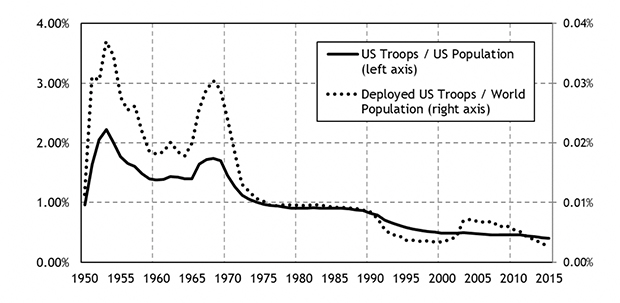
American soldiers have literally been sent to every corner of the globe. In a typical year, 15 countries are home to one thousand or more U.S. troops, and another 15 host between one hundred and one thousand troops. Among all the countries of the world as well as protectorates and administrative zones, only four have had no U.S. troop presence since 1950.
Surprisingly, the percentage of the U.S. population serving on active duty is lower today than at any time in the modern era, currently less than half of one percent, or 0.43% to be exact. Furthermore, today there are fewer deployed U.S. troops based overseas relative to the world population than at any time since 1950.
Table 1 shows the average annual number of troops based in each region of the world during six time periods. I divided the series at key points in recent history. The first period, 1950-1963, marked the peak number of forces in Europe, averaging nearly 350,000, and the peak number stationed in Latin America, averaging one-tenth that amount at 35,000. The second period, 1964-73, covers the years of the Vietnam conflict, when there were 450,000 troops per year stationed in Asia, which is the highest for any region in any period. During the third period, 1974-1980, the war in Vietnam was over and the AVF began. It was an era of stability in European troop levels, but a massive withdrawal of U.S. troops from Asia that could have been larger, as the previous section discussed. Despite efforts by the Carter administration and others in the U.S. foreign policy establishment, troop levels were kept stable in South Korea, Japan, and the Philippines, while cut sharply in Vietnam, Thailand, and elsewhere.
Table 1. Average Annual U.S. Troop Deployments by Region
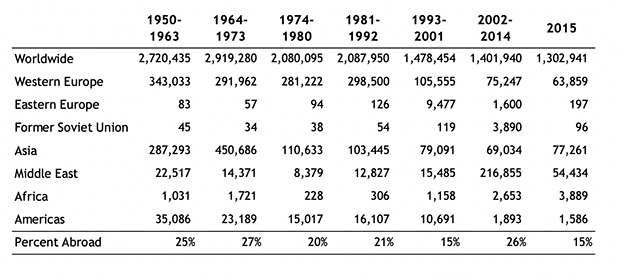
The fourth period, 1981-1992, covers the Reagan and George H. W. Bush administrations, Soviet adventurism in Afghanistan, and the sudden demise of communism in all the nations of Eastern Europe. U.S. forces in Europe actually rose by five percent during this period, but the Gulf War barely registers in this data because that global mobilization, conflict, and demobilization all occurred after the September 1990 count and ended before the 1991 count.
The fifth period, 1993-2001, marks the Clinton presidency, characterized as the time of the “peace dividend” because of expected military spending reductions. The average number of troops in Europe was just 100,000, or one third of the Reagan and Bush years. Troops in Asia were drawn down by roughly 25,000. However, the Bosnia conflict and intervention also occurred during the Clinton presidency. The final period, 2002 to 2014, immediately follows the 9/11 attacks, which precipitated OEF and OIF. The most interesting pattern that runs counter to conventional wisdom is the decline in total forces worldwide (which includes the United States) after 2001. There were roughly 100,000 fewer active duty troops after the 9/11 attacks than during the “peace dividend” era before.
Figure 3. U.S. Troop Deployments, stacked by region
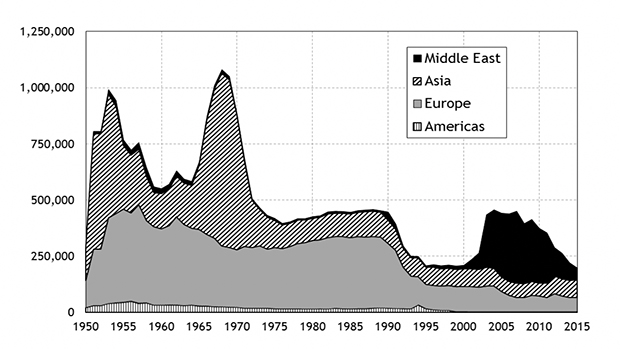
The global scope of American military power has been described in many ways: hegemony, primacy, and unipolarity. Brooks, Ikenberry, and Wohlforth (2012)1 cover the nuances of the terminology well, and I agree with their preference for the term “Deep Engagement” that Joseph Nye coined in a 1995 article.2 The complex patterns and nuances of engagement remain poorly understood, with a focus on conflict that ignores the preponderance of cases, where U.S. forces have been peacefully based for decades. In short, foreign policy has focused on the heat instead of the light – countless studies, essays, and books on Vietnam, Afghanistan, and Iraq stand in contrast to the negligible attention given to countries where the U.S. maintained large-scale and long-term troop basing such as Belgium, Korea, Turkey, and Kuwait.
Is the United States an empire? We may just as well debate whether an elephant most closely resembles a Tyrannosaurus Rex or Triceratops. Some will point to the imperial characteristics that are reflected in the United States force posture. But characteristics of dinosaurs or empires (size, martial strength, breadth) really have no meaning in a world where that entire order is extinct. The 21st century is filled with a new order of nation-states, markedly different from eras prior to 1945.
American power is best understood not by its type: hard, soft, or smart, but its motivation. This is not to say the “imperial” motivation has disappeared from human affairs; self-preservation and domination are instinctive human qualities. But there is a new aspect to international relations that has been in place for more than a century, a form of altruism, illustrated by the widespread support that exists in the U.S. and other countries for universal human rights. For many decades now, nations have routinely sought to advance something beyond their narrow national interests. I call this a Promethean motivation, and America a Promethean power.
The phrase is rooted in the myth of Prometheus, the rebellious god of ancient Greek mythology who stole fire from Zeus and gave it to the human race, sparking the beginning of technology, growth, civilization, and prosperity. Zeus was the ruler of the Gods of Olympus, archetype of the emperor/king. The Gods were rulers, and humans were mere subjects. Prometheus represents rebellion, the trickster God, undercutting the authority of the imperial order. Legend has it that Prometheus tricked Zeus – repeatedly – in order to help uplift the human race.
Critics of American intervention reflexively use the term “imperial” when discussing foreign affairs. By far the dominant theme of imperialism in American foreign policy has been voiced by Leftist thinkers such as Howard Zinn, Gabriel and Joyce Kolko, and Gore Vidal. But since 1990, the end of the Cold War, neo-isolationists on the right have adopted the term as well, notably Pat Buchanan and Congressman Ron Paul. Thus the tendency is for thinkers on the political extremes – globalists on the left, nationalists on the right – to find common cause, whereas centrists tend to view American power more favorably, as do many foreign scholars.
Following the 9/11 attacks and concerns about state failure abroad, proponents of American intervention began suggesting American empire in explicit and favorable ways. Such voices included Richard Haas, Sebastian Mallaby, and Max Boot. The fullest expression of this new theme is found in Colossus, a 2004 book by Niall Ferguson3 (now a colleague at the Hoover Institution), who argued “not merely that the United States is an empire, but that it always has been an empire” and that the ultimate threat to the nation is its own “absence of a will to power.” The book is an unappreciated gem, but one wonders if Ferguson and his intellectual opponents share the same framework, which refuses to draw a line between imperial states of the 15th-19th centuries and the modern states of the 21st.
Ferguson wonderfully skewers the slipperiness of the term hegemon, which remains “the most popular term among writers on international relations.” Hegemony refers to a coercive state, like an empire, but one that aims to create mutually beneficial relationships. Trying to define the nature of state power by the distribution of benefits (exploitative or shared) misses the point. The point is: what are first principles that motivate foreign action?
America on the world stage should be understood in the context of its revolutionary founding. The republic’s anti-imperial birth and its sense of manifest destiny have colored foreign affairs from early on. Consider again Thomas Jefferson’s “Empire of Liberty,” which was more than a poetic phrase. In 1809 Jefferson wrote to his successor James Madison, “I am persuaded no constitution was ever before so well calculated as ours for extensive empire & self-government.” In one of his final letters, written in 1824, Jefferson wrote, “where this progress will stop no-one can say. Barbarism has, in the meantime, been receding before the steady step of amelioration; and will in time, I trust, disappear from the earth.”
To simplify matters, let’s accept the framework of definitions on the Left (and also popularly understood by Americans throughout history). Define an empire as a nation that exploits foreign peoples, aiming to colonize them and/or extract their resources for the advantage of the empire and at the cost of the foreigners. And for the sake of clarity, recognize a bright line that distinguishes imperial relationships as those where subjugated peoples do not want but are forced to abide by foreign intervention. To be specific, the U.S. role in South Korea fails the imperial test, as does the post-1955 role of the U.S. in Germany and Japan. Those three countries accounted for nearly three-quarters of U.S. troop deployments since 1950. Not to mention Spain, Turkey, Taiwan, and Kuwait. All of these are voluntary alliances, and qualitatively distinct from forces based in Iraq.
For the Leftist criticism of American empire to hold, evidence of domination should be easy to see. One would expect to see the countries of the world that are occupied by American troops suffering economic decline as a result, or at a minimum a relative decline. Here the critique falls apart. The countries of the world that have hosted the greatest number of American troops since 1950 have grown the fastest economically. Furthermore, host countries have experienced faster declines in child mortality, faster increase in overall longevity, faster growth in infrastructure, and even greater improvements in the broadly measured human development index (HDI). Consider as evidence the average economic growth rates presented in table 2, reproduced from Jones and Kane (2012).4[3]Table 2. Annual growth rate effect of U.S. Troops, by host country GDP per capita level in 1960 and size of troop deployment during 1950-2000.

The record shows that America’s engagement with allied nations is unequivocally beneficial for those countries. But the context is what matters for future policy choices. Public perceptions of world affairs are dominated by negatives: bombings in Iraqi cities, AIDS rampant in Africa, genocides, earthquakes. Foreign policy experts focus on negatives of a subtler nature: the dilemma over Iran’s pursuit of nuclear weapons, the poppy trade and corruption in Afghanistan, the strategic mystery that is China. Yet despite real and looming crises, the underlying theme of the American century is a patient march of human prosperity, deepening and broadening as economic growth unfolds in the free world.
The American strategy of patient, forward deployment of U.S. troops, even and especially when it is not self-interested, has benefitted our allies and the world. America’s engagement in Asia and Europe since 1945 created a security umbrella fostering peace and unprecedented prosperity. If this model were applied to the Middle East – supporting allies rather than hunting monsters – it would reshape the region’s future for the better. On this point, Fallows might agree.
The question that haunts contemporary foreign policy is not whether the U.S. military is a force for good around the globe. It is. The question is: Can Promethean power be sustained? Does the United States have the willpower to maintain a forward force posture?
Election results and recent data on troop deployments indicate American power is pulling back. Every recent president campaigned and won on a message of retrenchment, including Donald Trump, Barack Obama, George Bush, and Bill Clinton. Although each man once in the White House ordered a new deployment – only Bush increased the global footprint.
Figure 4. Projections of U.S. Military Troop Deployments
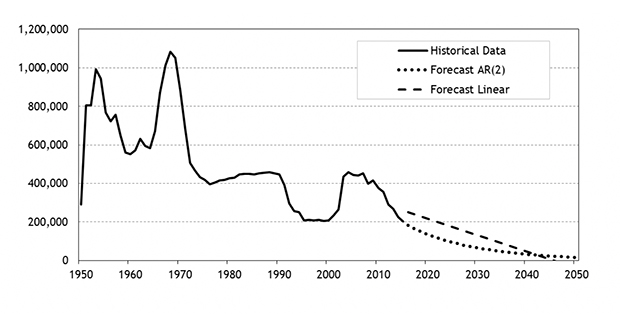
And facts are facts. Just over 1.3 million men and women were in uniform in 2015, compared to 2 million in 1990 (the end of the Cold War) and 3 million in 1970 (the middle of the Vietnam War). What does this mean? Linear and econometric projections indicate that the U.S. is on track to have essentially zero forces stationed on foreign soil by 2045.
It is said that the Romans could not imagine a world without Roman primacy until it was too late. The United States appears to be pulling back its commitment to global defenses, and only time will tell if the consequences for liberty will be negligible or cataclysmic. Regardless, the die is being cast.
Thomas Jefferson once remarked that eternal vigilance is the price of liberty. As any soldier stationed abroad can tell you, eternity is a long time. Soldiers may be so patient, but civilians it seems, are not.
1 William Wohlforth, “The Stability of a Unipolar World,” International Security 24, no.1 (Summer 1999): 5–41; Stephen G. Brooks, G. John Ikenberry, and William C. Wohlforth, “Don’t Come Home, America: The Case against Retrenchment,” International Security 37, no. 3 (Winter 2012): 7-51
2 Joseph S. Nye, Jr., “East Asian Security: The Case for Deep Engagement,” Foreign Affairs, July/August 1995: 90-102.
3 Ferguson, Niall, Colossus: The Rise and Fall of the American Empire (London: Penguin Books, 2005).
4 G. Jones & T. Kane (2012) U.S. Troops and Foreign Economic Growth, Defence and Peace Economics, 23:3, 225-249, DOI: 10.1080/10242694.2011.585043








